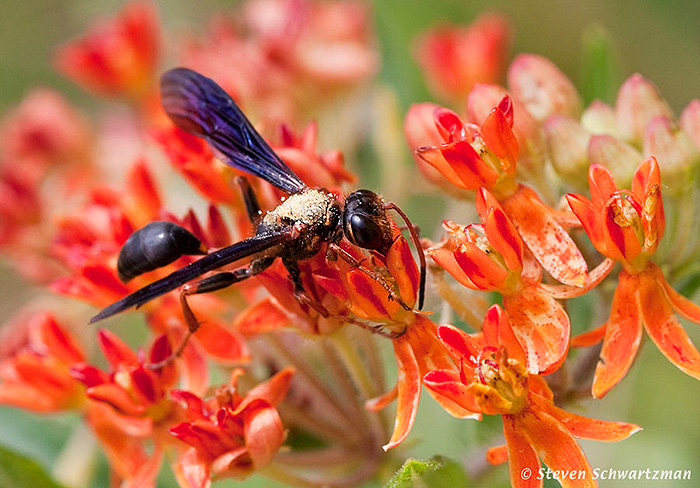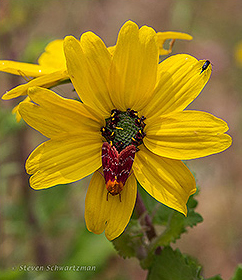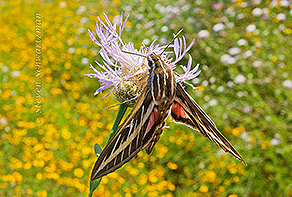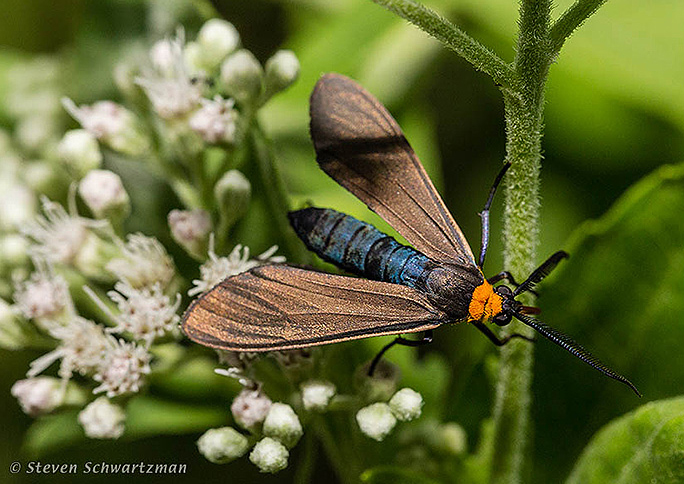Creature Comfort

Wasp on butterfly weed (Asclepias tuberosa). Next time you run for cover when a wasp is about, consider what benefits it brings to your garden. Not only do parasitic wasps control aphids, whiteflies, ants and more, they parasitize the eggs of several insects, such as tomato hornworms and cabbageworms.
OFTEN FALLING VICTIM TO SWATTING, STOMPING OR SPRAYING, insects live their lives in the balance. Though it might seem like bugs exist to irritate us, the truth is that these little creatures we often instinctively kill do play a vital role in our survival.
“Insects in your garden [most of which are native species] are absolutely essential, not optional,” says entomologist Doug Tallamy, Professor of Entomology and Wildlife Ecology at the University of Delaware. “Our mindless war against all insects is the worst thing we could do.
Nearly all living beings rely on insects in some way. The Pulitzer Prize-winning author and renowned ecologist E.O. Wilson even called insects ‘the little things that run the world.’”
While the aversion to certain pesky insects like houseflies is understandable, the animosity is misplaced, says Tallamy, author of “Bringing Nature Home” and “The Living Landscape.” He notes that of the 4 million or so insect species on earth, less than 1 percent are actual agricultural and nuisance pests. The other 99 percent are beneficial or benign.
Beneficial insects perform a variety of essential functions, such as pollinating plants, returning nutrients in dead animals and plants to the soil, and aerating soil. “If we lost our pollinators, we’d lose 80 to 90 percent of our plants and experience an ecosystem collapse,” says Tallamy.
“Insects have co-evolved with plants for millions of years, each complementing the other by filling various needs in the balance of the ecosystem,” says Jessica Walliser, a horticulturist and author of “Attracting Beneficial Bugs to Your Garden” and “Good Bug Bad Bug: Who’s Who, What They Do and How to Manage Them Organically.”

Unidentified reddish-orange moth on flower of Texas green eyes (Berlandiera texana).
“Some native insects serve as specialized pollinators whose mouthparts have evolved to access nectar from particular flower shapes,” she says. “Others fill the role of predator or parasitoid, helping maintain the balance of the ecosystem by consuming other insects or parasitizing them. And decomposer insects play the critical role of breaking down various organic wastes so we aren’t up to our necks in dead stuff and poop.”
Though they get a lot of attention, insects like bees and butterflies comprise a small segment of the millions of insects on the planet, says Tallamy. “Most insects go unnoticed yet are critical to the functioning of our ecosystem.”
Among the unsung heroes are moths, which greatly outnumber butterflies. “There are almost 14,000 species of moths in North America alone. They pollinate at night and provide critical food in the form of caterpillars for birds, which rely on insects to rear their young,” says Tallamy. Raising one clutch of Carolina chickadees requires 6,000 to 9,000 caterpillars, which grow in great numbers on various native trees.
At this time of year, your garden may be home to tomato or tobacco hornworms, which happen to be a favored meal of israconid wasps. These wasps lay their eggs inside of the caterpillars, and the resulting larvae tunnel out of the hornworm and make white cocoons on their backs.
“Many people see the cocoons and assume they’re hornworm eggs, but they’re not,” says Tallamy, who explains that the only way to have such species of parasitic wasps is to have hawk moths in your garden, which may come if you grow native viburnum, native coral honeysuckle or native grape. Parasitic wasps are also known to control ants, aphids and more.

Hummingbird moth on American basketflower (Centaurea americana).
Fireflies also make their debut in the warm months, and there are about 150 different species in North America. “Not all fireflies glow as adults, but all do as larvae. Each species has its own distinct flash pattern primarily used to attract a mate,” says Walliser. Firefly larvae are predaceous, crawling around the ground, eating slugs and snails and other ground-dwelling invertebrates. Adults of most species eat pollen and nectar, but some eat nothing at all. Some firefly species spend years as larvae, while most adults are short-lived.”
If you have a pond in your backyard or live near a stream, marsh or lake, dragonflies are also likely to make an appearance. Dragonfly nymphs feed on mosquito larvae, keeping them in check. The adult dragonfly features wings that aren’t synchronized. As a result of these mechanics, the insect is an efficient flier, able to hover perfectly still and fly forward and backward quickly.
The minute pirate bug is another ubiquitous insect that does its work under the radar. They are about one-sixth of an inch long at maturity and eat many different pests, including thrips, aphids, mealybugs, and bean and potato beetle larvae.
Every insect has a story and a function in the garden. Instead of striving to protect plants from bugs, focus on protecting insects. They’ll pay you back many times over by protecting and enriching your native landscape.

Ctenucha moth on late boneset (Eupatorium serotinum). There are 14,000 species of moths – night pollinators that provide critical food in the form of caterpillars for birds.
Gimme Shelter
PROVIDING REFUGE FOR INSECTS IN YOUR GARDEN
Given the critical roles insects play in the health of our planet, it makes sense to encourage their survival – but insects are in trouble. “We’ve chopped our world into isolated fragments of habitat that are too small and one-dimensional to sustain insect life,” says entomologist Doug Tallamy.
Fortunately, there are actions gardeners can take to save insects and encourage active populations.
PLANT LAYERED LANDSCAPES
“It’s time to give up the outdated notion that humans are here and nature is someplace else, because there is no someplace else anymore,” says Tallamy. “If birds, which need many caterpillars to raise their young, can’t find them in your backyard, they probably won’t have any luck in your neighbor’s yard or at a shopping center down the street. Even local parks don’t always have enough space or vegetation to maintain sufficient insect populations.”
The key is to plant a diverse and substantial landscape of natives in your yard, including groundcovers, shrubs, trees and vines, so that you provide a stable food web and breeding grounds for a wide variety of native insects.
GROW NATIVES
Most native insects have co-evolved with native plants over thousands of years. That means that although all plant leaves may look the same to us humans, to insects the foliage and flowers of many alien species are inedible. Growing native plants is the best way to provide native insects with food.
AVOID SPRAYING
Don’t knee-jerk spray if you spot insects in your garden. “Use a smartphone app or a book or website to identify the insect,” advises horticulturist Jessica Walliser. “Many beneficial predatory insects have an ‘ick factor’ that leads to a lot of unfortunate deaths. ever seen a robber fly? They may be creepy-looking, but they’re really good for the garden. And tachnid flies look like houseflies but with bristly hairs covering their abdomens. They are pollinators and parasitoids of many common garden pests, including caterpillars and beetles.”
Stop waging war on predators and parasites, agrees Tallamy. “If you kill one assassin bug early in the season, you’ve destroyed the possibility of that one insect eating thousands of other insects all summer long.”
GET CONFIRMATION
If you’re concerned that you might have an invasive, alien insect in your yard, send a photo or bring in a sample to your local county agricultural extension agent. Most likely you’ll discover that the insect isn’t harmful but one of the “good guys,” which will confirm that your landscape is an ideal place for native insects to live.
Written by Julie Bawden-Davis

